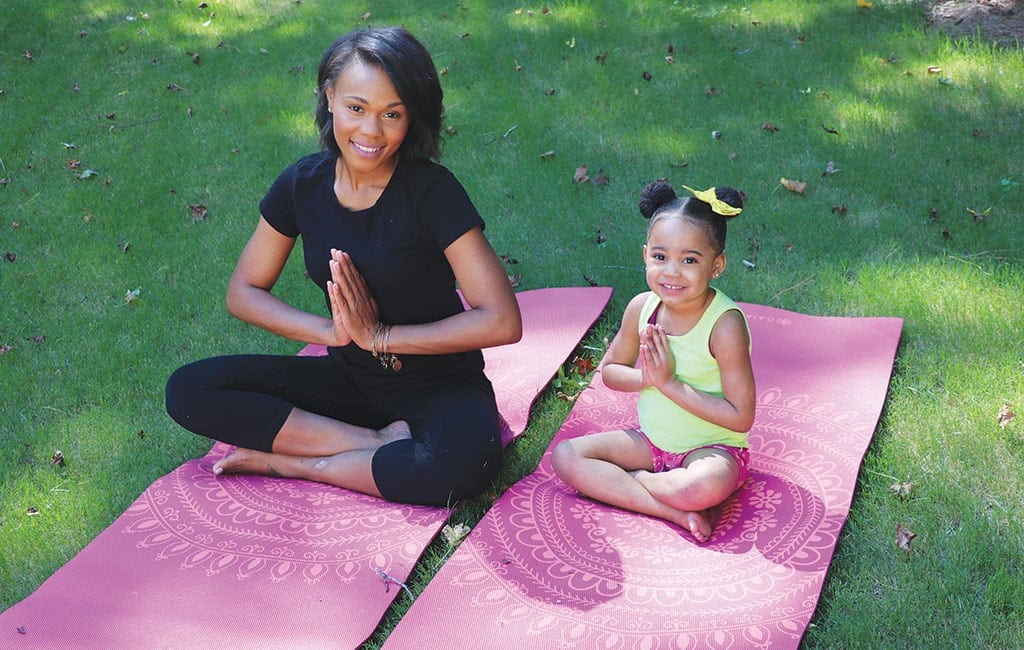Say Yes to Yoga: Ways Kids and Parents Benefit

Kids, parents and families benefit through flexibility, fitness and coping skills.
If you think yoga is about flexibility, challenging poses and a Zen attitude, you’ve got part of it. Yoga has physical and emotional benefits for people of all ages including children.
“Getting kids involved in yoga and meditation is a life-long win for them. Both yoga and meditation teach kids the benefits of fitness, but they are also valuable coping skills that kids can key into during life’s challenges,” says yoga teacher Kerin Monaco.
Table of Contents
Serenity, Strength, Self-Confidence
Monaco started practicing yoga herself in high school to combat crippling anxiety that cropped up around SATs and college applications. She went on to teach yoga and recently began to share yoga with her young family. When her daughter was 9 months old, Monaco started to practice with her on the mat, where they both loved the peaceful energy that yoga brings.
That peaceful energy is one of the key reasons adults practice yoga, and that calm is great for kids too. That’s not the only benefit though.
Yoga teacher Katy Dagle, says that for younger kids, yoga builds coordination, balance and self-regulation. For older kids, yoga continues to help with coordination and balance and also helps build flexibility, strength and self-confidence. The emotional benefits can be especially helpful in the challenging tween and teen years. In addition to these physical and emotional benefits, yoga can help develop values, such as honesty and nonviolence. These values are an integral part of yoga that is often overlooked, but they can be an added benefit to families practicing together.
Start with Classes
An experienced teacher helps children learn poses correctly and can offer modifications or adjustments to things that don’t feel right. Kids (and grownups) should be reminded to do what feels right for their body. Not every child can do every pose, and some days a familiar pose is harder than others.
Yoga is noncompetitive. Teachers should help kids focus on their own practice every day and create a supportive environment.
To find kids’ classes, use Atlanta Parent’s guide to kid-friendly studios or check with local yoga studios, gyms or YMCAs. (Some studios have an age restriction, so it’s good to check first.)
Once familiar with yoga, kids can use videos and yoga cards to practice at home.
Practice Anywhere
Classes provide a safe introduction to yoga and ongoing support, but the beauty of yoga is that you can practice any place and any time. Here are two practices you can do anywhere:
Breathe
Breathing can be centering, energizing or calming. For parents, try breathing deeply while holding an upset child. Dagle uses “flower breathing” with her toddler: sniff a flower, let it go with a sigh, to help diffuse big emotions.
Dagle teaches older kids to use breathing exercises to calm themselves before a test. She encourages them to put their feet firmly on the ground at their desk, inhale for a count of four, and exhale for a count of six for one minute to help them feel both calm and grounded.
Be Present
Practice mindfulness and being present. That means noticing your environment. There are lots of ways to practice this with kids – you don’t even have to call it mindfulness.
Sit quietly together or go for a walk, and see what you notice. Try closing your eyes. What sounds and smells do you sense?
Turn off your phone and spend time doing an activity with your kids, whether it’s reading, coloring, dancing, snuggling or building. Just focus on what you’re doing, with no distractions.
Describe something familiar as if it were new. In an exercise from “Planting Seeds: Practicing Mindfulness with Children” by Thich Nhat Hanh, kids pretend they are Martians seeing something from Earth for the first time. Hand your kids a familiar object (the book uses raisins, but you can use any simple object or food kids “see” every day). Remind them that they have never seen it before. Ask them to look, touch, smell, listen and taste and describe their experience.
Yoga builds strength and flexibility, self-confidence and focus. Kids get comfortable in and connected to their own bodies and minds, and learn practices that they use for the rest of their lives.
Yoga Tips and Tools
For Parents:
- Get back on the mat after having a baby, as your doctor gives the OK. Just remember to meet your practice where it is. Your body has been through a lot.
- Practice with your kids around. Put your baby on the mat with you or use your mat in the kids’ playroom. If you’re used to a peaceful yoga studio, practicing with your kids around will be different, but still beneficial.
- Remember that your yoga is good for your kids. It may feel selfish to take time for a class or home practice, but it’s worth it.
For Families:
- Keep it fun. Use yoga songs and games. Let kids pick or even lead poses. If energy levels are high, try some poses or actions to use some of that energy before shifting to something calmer.
- Remember you can practice anywhere. Remind kids to use their breathing when they are getting frustrated. If you can’t get kids to take a deep breath, try taking calming breaths yourself. It helps keep you from getting worked up and helps change the dynamic in the room. Try mindfulness on long car trips or while waiting in line.




